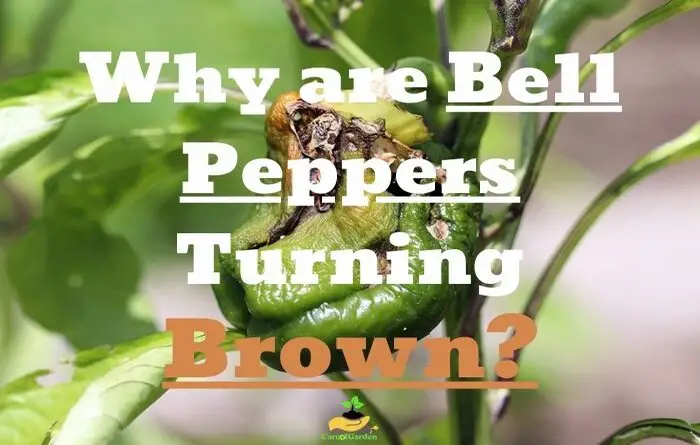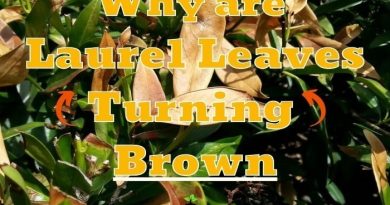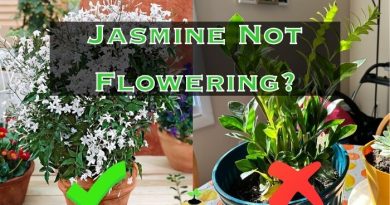Why are Bell Peppers Turning Brown? (7 Causes & What to Do)
Brown-spotted bell peppers cause a lot of headaches for home gardeners. But why are bell peppers turning brown? There are several reasons why are your bell peppers turning brown and fall off the plant. Find out the source of the problem so you can have your blooms ripening into tasty peppers.
If there are brown spots on the bell peppers, the cause is probably environmental, and this is often due to inconsistent watering or caused by sunburns from the sun. Blossom end rot is the usual culprit for this and will start as a small brown to tan spot on the bottom end of the bell pepper fruits.
This guide will inform you about the causes of one of the most common reasons for bell pepper brown fruits.
| Causes why Bell Peppers are Turning Brown |
|---|
| 1. Calcium deficiency (Blossom End Rot) |
| 2. Water imbalance |
| 3. Sunburn / Scald |
| 4. Tobacco Mosaic |
| 5. Phytophthora (Brown Rot) |
| 6. Anthracnose |
| 7. Alternariosis |
Causes why Bell Peppers are Turning Brown
1. Calcium deficiency (Blossom End Rot)
More commonly known as “brown bottom”, blossom end rot is a disease determined by calcium deficiency more precisely. During their development, the bell pepper have a significant need for calcium, and it is when they lack it that this black-brown spot forms on the bell pepper fruit side which grows faster than the fruit (peppers but also tomatoes and squash).
One of the most important symptoms of blossom end rot is a water-soaked brown spot located on the fruit or on the side of the bell pepper. The stain increases in size, dries, and eventually sinks in and takes on the appearance of leather.
This disorder is caused by a localized calcium deficiency that begins when calcium levels are deficient, or more commonly when fruit grows rapidly and soil moisture is insufficient. To avoid blossom end rot, keep calcium levels within optimal ranges and practice good moisture management.
First of all, such fruits with brown spots can be seen if they touch the ground, as it develops with high humidity.
Even before the spots appear, you can notice the first signs of vertex rot, which appear as some kind of watery areas of the fruit, after which brown spots appear in these areas, and the surface of the spot is pressed.
How do you fix brown spots cause by blossom end rot on bell peppers
Causes of blossom end rot : uneven watering (alternating drought and waterlogging), as well as large doses of nitrogen fertilizers that interfere with the absorption of calcium.
This disease manifests itself on pepper when the bush cannot provide the pepper fruit with calcium in sufficient quantities. Therefore, spray the pepper or feed it (root dressing) with calcium nitrate. In the initial stages of the disease, calcium nitrate can be fed .
The symptoms occur mainly in seasons in which hot and cold or dry and wet periods alternate very frequently. Irregular watering units determines calcium deficiency.
How to prevent Blossom End Rot on Bell Peppers:
Therefore, make sure that your peppers get water evenly. The ideal soil pH is between 6.2 and 7.0. If you find that the soil contains too little calcium, you should water the plants with tap water. Special fertilizers can also improve the calcium content in the soil.
A lack of necessary nutrients for your pepper plant can cause stress on the plant. Also, because the flower is the beginning of a bell pepper fruit, without enough vital nutrients to fuel its development, the flower will turn brown and die.
As flower buds develop on your pepper plant, the amount of nitrogen decreases as the phosphorous and potassium feed increases. A 5-10-10 formulated fertilizer is a common mix to use once flower buds appear and through fruit development.
2. Water imbalance
A lack of water causes a reaction of the bell pepper to quickly remove water and thus interfere with the transport of calcium.
It happens because the lack of water hinders the circulation of vital substances for the plant, which in this way are diminished.
On the other hand, an excess of water can also cause the bell pepper to start turning brown because the moisture remains in the hollow of the bell pepper, leading to necrosis of the tissues or, in any case, to the formation of fungi. This problem causes the formation of concentric brown spots at the base of the fruit.
Water imbalance can be eliminated by a sharp change in the water regime of the bell pepper plant.
To do this, when watering, you must do the following :
- when moistening the soil, the soil should be soaked to a depth of no more than 0.6–0.7 m;
- water only the soil near the root column,
- moistening the row spacing is irrational;
- the procedure is carried out as needed, only after the appearance of a small dry crust about 4 cm thick on the site;
Sudden changes in the humidity of the substrate are detrimental. The optimal indicator should be within 70%, watering is carried out in the early morning or late evening, and only under the root.
Does your pepper leaves turn white? If so, here are the 5 common reasons why and how to treat it.
3. Sunburn or Sunscald
The heat and excessive exposure to the sun causes light, yellowish or brownish patches that affect the part of the bell pepper hit by the sun. In this case, the bell pepper plant must be shaded (there are special nets), or since you grow in pots you can move the peppers to a less exposed point.
This disorder occurs when the bell pepper fruit is exposed to too much heat and too much light. The tissue is damaged and takes on a brown color.
Ripe green fruit is susceptible to this disease. To avoid sunscald, select cultivars with good leaf cover to keep fruit protected and take steps to prevent lodging areas from forming.
Staking to keep plants upright can reduce scald and lodging hazards. When plants become lodged (the stem bends downward) the fruit can be exposed to direct sunlight, resulting in sunscald.
The bell pepper plant cannot maintain its water balance. If the pepper has already developed fruit, brown or black spots appear more frequently on the sunlit sides. These sink due to the drought.
Peppers have dry, necrotic spots caused by burns from excess heat. The damage is enhanced by other factors, such as the strong brightness and low humidity of the air.
The action of the sun’s rays increases brightness, while dry air accentuates the transpiration of the leaves, which is not compensated by the absorption of water by the roots.
Most affected are the bell peppers closest to the ground, being more exposed to the sun’s rays burn, and the tip of the fruit, as it has softer tissues.
How to fix brown spots cause by Scald on Ball Peppers
Slowly acclimate your bell pepper plants to the sunny location. Shade them temporarily with garden fleece and make sure that even strong plants are not exposed to the blazing midday sun.
Strongly pinched bell pepper plants tend to produce brown fruits because there is no natural shading. Therefore, do not remove too many shoots, so that the fruits are better protected from the sun.
Sunburn is also caused by water droplets remaining on the fruit and refracting the sunlight. Be sure to only water the plant at the base. Fruits and leaves should not be watered.
4. Tobacco Mosaic
Another disease that causes brown spots on bell peppers is tobacco mosaic virus. Yellow to brownish spots form on the fruit. As a result, the peppers wither and the leaves die off. This disease is also highly contagious and cannot be fought. Therefore, infested plants and all plant residues must be disposed of.
This disease is caused by a virus that spreads easily and overwinters in the soil. When the bell pepper is affected, a mosaic-like pattern of brown and dark spots can be seen on the leaves.
Bell pepper plant growth is also severely restricted, and brown and sunken spots, thickened veins, and brown stalks appear on the bell pepper fruits.
However, the symptoms that appear are not always the same. Other types of damage can also become visible:
- increased formation of side shoots
- deformed leaves
- brown color in the bell pepper fruit
The highly contagious disease leads to a low crop yield. So far there are no means by which the virus can be fought. Remove affected plants from the stock and ensure that the virus cannot spread further.
Aphids pose a threat. Green peach aphids and black bean aphids are the main vectors of the disease.
How to prevent Tobacco Mosaic on Bell Peppers
Strengthen your Capsicum plants with nettle manure or horsetail decoction and avoid over-fertilizing. Above all, an excess of nitrogen has a negative effect on the vitality of the bell pepper plants.
- Clean garden tools carefully
- Wash shoe soles
- Check other plants for infestation
5. Phytophthora
If affected home gardeners can rule out blossom end rot as the cause of brown spots on bell peppers , a dreaded fungal infection comes into focus. Phytophthora spores are the causative agents of late blight.
Since bell pepper varieties also belong to the nightshade family, the fungi do not spare these plants. Rather, with Phytophthora capsici, a subspecies of the fungus genus has formed, which has specialized in infesting pepper plants.
Brownish spots form on the peppers, which sink in over time. The flesh underneath has dried up and hardened.
Fatally, the symptoms are similar to blossom end rot, making diagnosis difficult for the layperson. In private cultivation, potatoes are the first to be affected, followed by tomato and pepper plants.
If you are already struggling with late blight in the potato bed, it cannot be ruled out that your bell pepper cultivation will be affected. As a further distinguishing feature, brown spots in combination with white-grey mold growth spread to the leaves and shoots before the bell pepper fruits rot in the event of a fungal infection.
In the absence of effective control agents for private users, pepper plants infected with brown rot should be uprooted and destroyed promptly.
Fortunately, the symptoms are fairly clear, so if you see the first signs, you can prevent the infection from spreading. Cut off infested leaves and dispose of them in household waste.
Since the spores can hibernate in the soil and on plant debris for up to seven years, you should not dispose of the leaves in the compost.
To prevent phytophthora in bell peppers fruits, you should pay attention to coordinated care. Rain-protected and sunny locations are suboptimal for the growth of fungal spores.
Plant resistant varieties and support the vitality of the plants with natural tonics from stinging nettle and field horsetail.
- Pour peppers at the base
- Cut down to three shoots for good ventilation
- Mulch root ball
Does your pepper have purple spots or turning purple? Here are the top 4 causes why is it happening!
How to fix brown spots cause by Phytophthora Blight on bell peppers
To control phytophthora, do the following :
- avoid planting in infested soils;
- do crop rotation;
- use healthy seeds;
- use propagating material, free from contaminants;
- use preventive treatment with copper-based fungicides;
- drain the beds well;
- avoid waterlogging;
- not burying the rest of the crop in the greenhouse areas;
- use resistant materials;
- perform chemical control on the shoot after infestation.
6. Anthracnose
Anthracnose is a fungal disease that causes black or brown spots all over the bell pepper plant, and while you can try fungicides to get rid of it, it’s best to rule it out entirely.
It affects the aerial part of the plants, especially the bell pepper fruits. It causes significant damage due to the presence of circular, depressed lesions of different sizes.
It affects the stems with symptoms of dark lesions in the form of streaks, and on the leaves it forms necrotic, dry, irregular and brown spots. In some cases, a mass of fungal structures (spores) of pink, salmon or orange color can be observed, which stand out in the green of the fruits.
The symptoms of this disease include sunken brown circular spots on the leaves and on ripe or ripening fruits.
Typical symptoms appear on ripe fruits, in the form of circular spots with more or less 0.5 to 1.0 cm in diameter. First they are watery and then necrotic.
Sometimes these brown spots can become covered by very fine hairs, giving them a black color. Already in conditions of high humidity, the spots become pink.
Over time the centers of the spots develop black spores. Management strategies through cultural practices include crop rotation and removal of fruit in the early stages of infection from the field.
How to prevent Anthracnose on Bell Peppers
To prevent anthracnose we must:
- do crop rotation;
- disinfect seeds;
- use chemicals;
- use resistant cultivars or hybrids.
7. Alternariosis
Perhaps this is Alternariosis (or dry spotting). It is most commonly found on bell peppers grown outdoors. But in greenhouses, this disease becomes noticeable only by autumn.
These rotten brown spots can later be covered with a black moldy coating. This is how the fungal nature of the disease manifests itself. For such a peculiar manifestation on the fruit of pepper, the disease is also called “brown mold of pepper fruits.”
On the fruit of pepper, rounded in shape and slightly depressed watery spots appear, which then gradually darken, but the center of the spot becomes lighter.
Alternariosis mainly appears on the leaves. They form rounded brown or brown spots. If the weather is humid, then these spots are covered with a velvety black coating. This plaque is the spores of the fungus. Because of this color of the spots, the disease is also called “brown pepper spot”.
At the beginning of the development of the disease, the affected leaves and single diseased bushes should be removed, and if diseased fruits are found, the pepper must be collected and destroyed.
To combat alterniosis in pepper, biological products can be used. With the help of the same preparation, seeds can also be treated before planting.
How to prevent bell peppers from turning brown
To prevent bell peppers from turning brown follow these steps:
| In the greenhouse | In open field |
|---|---|
| 1. Keep the soil loose. | 1. Provide good ventilation and light by pulling out the weeds. |
| 2. Keep the humidity levels no more than 60%. | 2. Apply a large amount of fertilizer before bell pepper starts flowering. |
| 3. Water the soil as it dries under the bell pepper root for 1-2 times a week. | 3. Water bell peppers regularly using a drip irrigation system. |
| 4. Apply fertilizer on time. | 4. Mulch the soil at the base of the bell pepper. |
| 5. Make sure the soil temperature is within 77°F (+25 °C). | 5. Use trims to prevent pest infestations. |
In addition to the optimal location and care conditions, you can protect bell peppers against brown spots with the following measures:
- Choose resistant pepper varieties
- Accompany the cultivation with tonics, such as liverwort extract or horsetail broth
- Pull each plant with a maximum of three shoots
- Avoid any injuries to bell pepper shoots and fruits
- Pinch pepper plants regularly for airy growth
- Mulch root discs with straw to avoid splashing water
- Do not overwater bell pepper plants
Frequently Asked Questions
Blossom end rot is the usual reason why bell peppers are turning brown and will start as a small brown to tan spot on the bottom end of the pepper.
Bell peppers have dry, necrotic spots caused by burns from excess heat. The damage is enhanced by other factors, such as the strong brightness and low humidity of the air.
Yes, the bell peppers are safe to eat. You just have to cut off the affected brown areas. However if the bell pepper fruit no longer looks fresh, if there are soft, mushy areas, extensive discoloration or if you discover mold, we advise you not to eat the peppers as a precaution.
It is best to immediately remove the bell peppers that have brown spots. This prevents the disease from spreading. Then the cause of the brown stains must be investigated in detail in order to take effective countermeasures.




